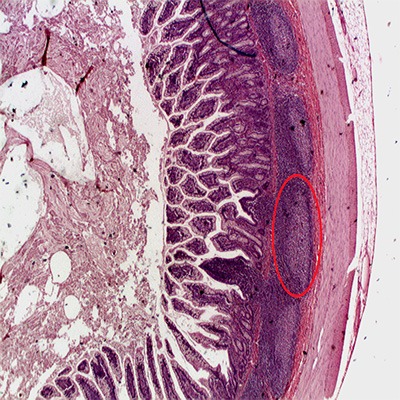What Are Peyer’s Patches and How Do They Protect Your Gut?

A Basic Understanding of Peyer’s Patches
Maintaining your health involves more than just treating symptoms; it requires awareness of how your body functions and the subtle signs it gives when something is wrong. One vital, yet often overlooked, part of your immune system lies in your gut: the Peyer’s patches. These lymphatic tissues, named after 17th-century Swiss anatomist Johann Conrad Peyer, play a crucial role in defending your body against harmful invaders. In this article, we will explore the essential role of Peyer’s patches in your immune system and their connection to various dis-eases.
Peyer’s patches are not something you hear about often, but they are critical to gut health and overall immune function. These clusters of organized lymphoid follicles are primarily located in the lamina propria and submucosa of the ileum, the distal portion of the small intestine, where they house numerous lymphocytes and macrophages. Although they can also be found in the jejunum and duodenum, more than 50% are concentrated in the ileum (the last part of the small intestine, where food is digested and nutrients are absorbed).
What Do Peyer’s Patches Look Like?
Visible to the naked eye, Peyer’s patches appear as small, elongated, or oval clusters of lymphoid tissue. They are pale or whitish, slightly raised areas against the semi-translucent greyish background of the small intestine mucosa, appearing as thickened regions in the intestinal lining, especially in the ileum. On the left is a color-enhanced cross-section of the ileum with a Peyer’s patch (circled).

Interestingly, Peyer’s patches increase in number until ages 15-25 and then begin to decline as we age. They play a pivotal role in the immune system of the gut, identifying antigens and producing antibodies to defend the body. As the first line of defense against microbial and dietary antigens, Peyer’s patches also help prevent the overgrowth of harmful bacteria.
How Peyer’s Patches Protect Your Gut and Immune System
- Immune surveillance: Peyer’s patches continuously monitor the intestinal lumen for harmful microbes and antigens, initiating an immune response when necessary. This process, known as immunosurveillance, activates both B and T lymphocytes to protect the body.
- Preventing bacterial overgrowth: They play a crucial role in maintaining the balance of intestinal microbiota, preventing the overgrowth of pathogenic bacteria.
- Inducing oral immune tolerance: Peyer’s patches contribute to developing tolerance to non-harmful antigens introduced via oral ingestion.
- Local immune response: These patches are involved in initiating local immune responses to live bacteria present in the intestine.
- Identifying antigens: M-cells within Peyer’s patches survey the intestinal lumen, detecting microbes and antigens for the immune system to target.
- Producing antibodies: Peyer’s patches help produce antibodies that defend the body against harmful invaders.
- Part of the GALT: Peyer’s patches are a crucial component of the gut-associated lymphoid tissue (GALT), which is the largest lymphatic organ in the body. Like the GALT, Peyer’s patches monitor and respond to potential pathogens that enter the digestive system.
Disorders Associated with Peyer’s Patches
- Prion disease: An abnormal increase in the size or number of Peyer’s patches can heighten the risk of prion diseases. Prion disease is a rare, fatal brain disorder caused by misfolded proteins, leading to symptoms such as memory loss, dementia, hallucinations, personality changes, and movement difficulties.
- Intussusception: This life-threatening condition occurs when part of a child’s intestine folds into another section, blocking the passage of food. It is the leading cause of intestinal obstruction in children aged 3 months to 6 years, with boys being four times more susceptible than girls. Children with larger or more numerous Peyer’s patches may be at increased risk. Symptoms include:
- Sudden onset of intermittent abdominal pain
- Straining
- Drawing knees to the chest
- Irritability
- Loud crying
- Vomiting
- Bloody stool or red, mucus-like stool
Without prompt treatment, intussusception can lead to severe complications such as intestinal infection, internal bleeding, and peritonitis. If your child exhibits recurring episodes of abdominal pain, seek immediate medical attention.
- Inflammatory bowel diseases: Peyer’s patches may play a role in the development of inflammatory bowel diseases, such as Crohn’s disease and ulcerative colitis.
- Typhoid fever: Salmonella typhi, the bacterium responsible for typhoid fever, can enter the body through Peyer’s patches.
- Whipple’s disease: a rare systemic disorder that involves malabsorption from the gastrointestinal tract (mainly the ileum) and affects other systems, such as the cardiovascular, central nervous system, joints, and vascular systems. Early disease recognition is essential to decrease the morbidity and mortality of Whipple disease.
- Intestinal necrosis: In rare cases, abnormal proliferation of Peyer’s patches after MMR vaccination in infants can result in small bowel necrosis, a life-threatening condition caused by reduced blood flow to the intestines.
In Conclusion
Peyer’s patches, though seldom mentioned, are vital to your immune system and gut health. Recognizing the symptoms of disorders associated with Peyer’s patches and seeking timely treatment can be lifesaving. While there may be few natural remedies for these disorders, awareness and swift medical intervention are key to preventing severe complications. Inflammatory bowel disease is one notable exception, and I will address natural approaches for managing it in a future article.
Although there are no known herbs to reverse the disorders linked to Peyer’s patches, the knowledge shared here aims to increase awareness of their critical role in your health. Remember, early detection and intervention are crucial to avoiding more severe outcomes, including potentially life-threatening complications.
I hope this article has deepened your understanding of this often-overlooked aspect of the immune system. Until next time, my friends—happy healing, and God bless.
